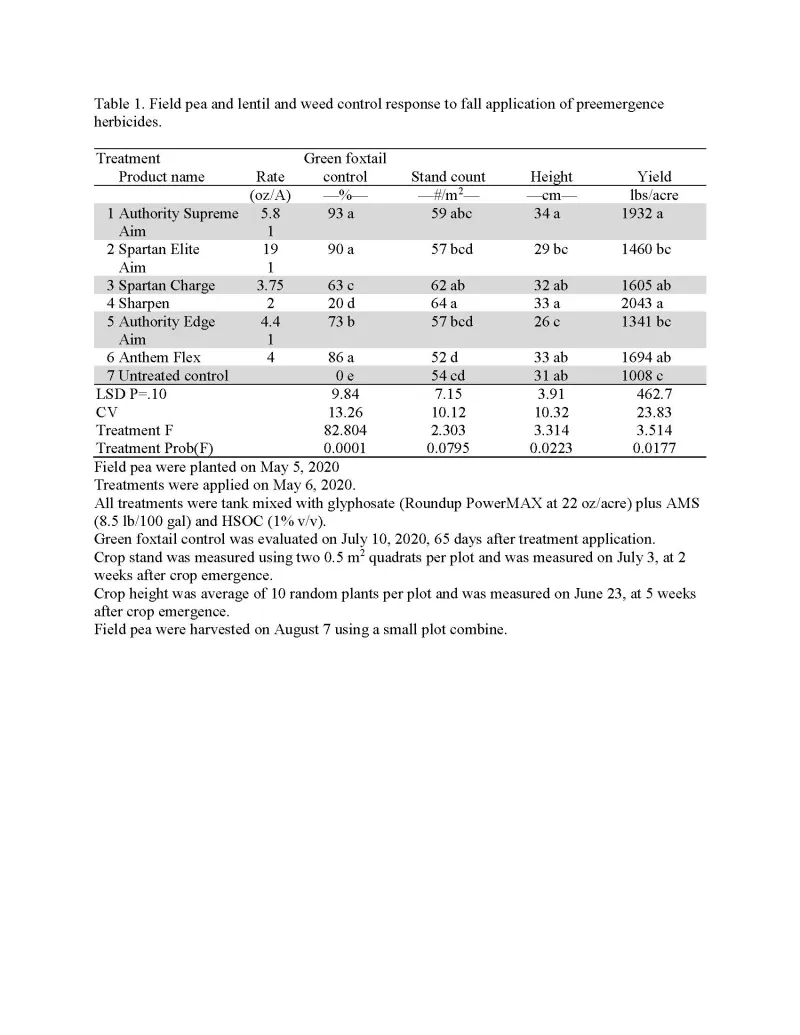Caleb Dalley and Daniel Abe
Hettinger Research Extension Center
A trial was conducted to evaluate field pea response and resulting weed control from spring application of soil active preemergence herbicides. Field pea ‘Salamanca’ was planted on May 5, 2020 using a no till drill at a rate of 120 lbs seed per acre at a depth of 2.5 inches. On May 6, herbicide treatments were applied using a tractor-mounted research sprayer at a spray volume of 10 gallons per acre using 8002XP flat fan nozzles. All treatments were tank-mixed with glyphosate (Roundup PowerMAX at 22 oz/acre) + AMS (8.5 lbs/100 gallons) + Destiny HSOC (1% v/v) to control weeds that had emerged prior to planting. The herbicide carfentrazone (Aim) was added at 1 oz/acre to improve control of winter annual weeds in all treatments except Spartan Charge (carfentrazone plus sulfentrazone), Sharpen (saflufencil), and Anthem Flex (carfentrazone plus pyroxasulfone).
Crop stand was measured using two 0.5 m2 quadrats per plot on June 3, two weeks after crop emergence. Of the herbicide treatments, sulfentrazone plus carfentrazone (Spartan Charge) and saflufencil (Sharpen) resulted in stand counts greater than what was recorded in the untreated control. Stand counts for all other treatments were similar to the untreated control. Field pea height was measured on June 23, by measuring the height of 10 random plants per plot. Pea height was less following application of sulfentrazone plus pyroxasulfone (Authority Edge). All other treatments resulted in pea height that was similar to what was found in the untreated control. The months of May and June were very dry in 2020 and few weeds emerged with the crop. When significant rainfall did occur during the last week of June and first week of July, this rain resulted in the emergence of green foxtail. Control of green foxtail was evaluated on July 10, 65 days after herbicide application. Even with the lack of rainfall early in the growing season, the herbicide treatment that provided good or excellent control of green foxtail included Authority Supreme (sulfentrazone plus pyroxasulfone) with 93% control, Spartan Elite (sulfentrazone plus metolachlor) with 90% control, and Anthem Flex (carfentrazone plus pyroxasulfone) with 86% control. Other treatments resulted in fair or poor control of green foxtail. While both Spartan Elite and Authority Edge contain sulfentrazone plus pyroxasulfone, better control of green foxtail with Authority Supreme was likely due to the higher amount of pyroxasulfone in this herbicide formulation. Field pea was harvested on August 12 using a small plot combine (Kincaid XP). Yield of field pea was greater, compared with the untreated control (1008 lbs/acre), following application of sulfentrazone plus pyroxasulfone (Authority Supreme) at 1932 lbs/acre; sulfentrazone plus carfentrazone (Spartan Charge) at 1605 lbs/acre, saflufencil (Sharpen) at 2043 lbs/acre, and pyroxasulfone plus carfentrazone (Anthem Flex) at 1694 lbs/acre. All other treatments yielded similar to the untreated control.

